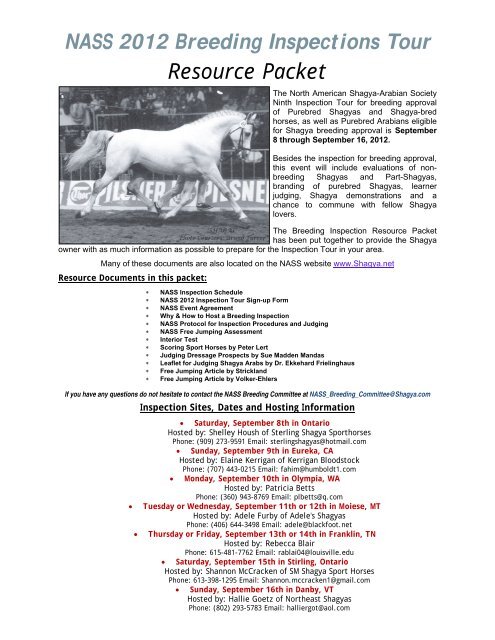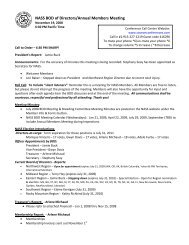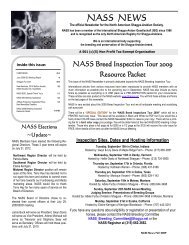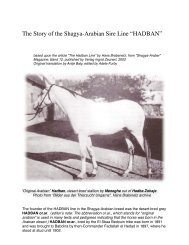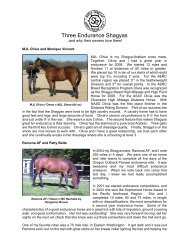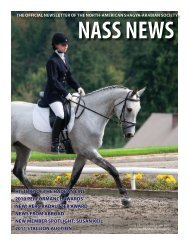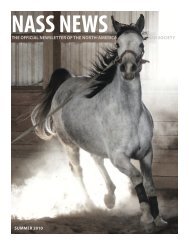NASS 2012 Breeding Inspection Tour Resource Packet
NASS 2012 Breeding Inspection Tour Resource Packet
NASS 2012 Breeding Inspection Tour Resource Packet
Create successful ePaper yourself
Turn your PDF publications into a flip-book with our unique Google optimized e-Paper software.
<strong>NASS</strong> <strong>2012</strong> <strong>Breeding</strong> <strong>Inspection</strong>s <strong>Tour</strong><br />
<strong>Resource</strong> <strong>Packet</strong><br />
The North American Shagya-Arabian Society<br />
Ninth <strong>Inspection</strong> <strong>Tour</strong> for breeding approval<br />
of Purebred Shagyas and Shagya-bred<br />
horses, as well as Purebred Arabians eligible<br />
for Shagya breeding approval is September<br />
8 through September 16, <strong>2012</strong>.<br />
Besides the inspection for breeding approval,<br />
this event will include evaluations of nonbreeding<br />
Shagyas and Part-Shagyas,<br />
branding of purebred Shagyas, learner<br />
judging, Shagya demonstrations and a<br />
chance to commune with fellow Shagya<br />
lovers.<br />
The <strong>Breeding</strong> <strong>Inspection</strong> <strong>Resource</strong> <strong>Packet</strong><br />
has been put together to provide the Shagya<br />
owner with as much information as possible to prepare for the <strong>Inspection</strong> <strong>Tour</strong> in your area.<br />
Many of these documents are also located on the <strong>NASS</strong> website www.Shagya.net<br />
<strong>Resource</strong> Documents in this packet:<br />
∗ <strong>NASS</strong> <strong>Inspection</strong> Schedule<br />
∗ <strong>NASS</strong> <strong>2012</strong> <strong>Inspection</strong> <strong>Tour</strong> Sign-up Form<br />
∗ <strong>NASS</strong> Event Agreement<br />
∗ Why & How to Host a <strong>Breeding</strong> <strong>Inspection</strong><br />
∗ <strong>NASS</strong> Protocol for <strong>Inspection</strong> Procedures and Judging<br />
∗ <strong>NASS</strong> Free Jumping Assessment<br />
∗ Interior Test<br />
∗ Scoring Sport Horses by Peter Lert<br />
∗ Judging Dressage Prospects by Sue Madden Mandas<br />
∗ Leaflet for Judging Shagya Arabs by Dr. Ekkehard Frielinghaus<br />
∗ Free Jumping Article by Strickland<br />
∗ Free Jumping Article by Volker-Ehlers<br />
If you have any questions do not hesitate to contact the <strong>NASS</strong> <strong>Breeding</strong> Committee at <strong>NASS</strong>_<strong>Breeding</strong>_Committee@Shagya.com<br />
<strong>Inspection</strong> Sites, Dates and Hosting Information<br />
• Saturday, September 8th in Ontario<br />
Hosted by: Shelley Housh of Sterling Shagya Sporthorses<br />
Phone: (909) 273-9591 Email: sterlingshagyas@hotmail.com<br />
• Sunday, September 9th in Eureka, CA<br />
Hosted by: Elaine Kerrigan of Kerrigan Bloodstock<br />
Phone: (707) 443-0215 Email: fahim@humboldt1.com<br />
• Monday, September 10th in Olympia, WA<br />
Hosted by: Patricia Betts<br />
Phone: (360) 943-8769 Email: plbetts@q.com<br />
• Tuesday or Wednesday, September 11th or 12th in Moiese, MT<br />
Hosted by: Adele Furby of Adele's Shagyas<br />
Phone: (406) 644-3498 Email: adele@blackfoot.net<br />
• Thursday or Friday, September 13th or 14th in Franklin, TN<br />
Hosted by: Rebecca Blair<br />
Phone: 615-481-7762 Email: rablai04@louisville.edu<br />
• Saturday, September 15th in Stirling, Ontario<br />
Hosted by: Shannon McCracken of SM Shagya Sport Horses<br />
Phone: 613-398-1295 Email: Shannon.mccracken1@gmail.com<br />
• Sunday, September 16th in Danby, VT<br />
Hosted by: Hallie Goetz of Northeast Shagyas<br />
Phone: (802) 293-5783 Email: halliergot@aol.com
NORTH AMERICAN SHAGYA-ARABIAN SOCIETY<br />
A 501 (c)(5) Non Profit Tax Exempt Organization<br />
<strong>Inspection</strong> <strong>Tour</strong> <strong>2012</strong> – Sign up Form<br />
Website: www.Shagya.net<br />
Please complete this form and return to:<br />
<strong>NASS</strong> Treasurer - Bev Thompson: 2345 S. Washington Road Columbia City, IN 46725<br />
<strong>NASS</strong> Member: ______Yes _____ No (Info to become a <strong>NASS</strong> Member for $45.00 – form on website - www.shagya.net)<br />
NAME: _________________________________ Phone: _________________________ Email: _______________________________<br />
STREET: ______________________________________ City: _______________________ State: _________ Zip: ________________<br />
<strong>NASS</strong> <strong>Inspection</strong> Date: _______________ Site Location you will be attending: ______________________________________________<br />
__________ Number of Horse’s that I will be bringing to the Site Location above.<br />
INSPECTION FOR SHAGYA BREEDING:<br />
Eligible are all <strong>NASS</strong> registered Purebred Shagyas, Part-Shagya-Arabians and Purebred Arabians 2 years and older.<br />
Horse Name & <strong>NASS</strong> Reg. #: ______________________________ Horse Name & <strong>NASS</strong> Reg. #: ______________________________<br />
Horse Name & <strong>NASS</strong> Reg. #: ______________________________ Horse Name & <strong>NASS</strong> Reg. #: ______________________________<br />
Horse Name & <strong>NASS</strong> Reg. #: ______________________________ Horse Name & <strong>NASS</strong> Reg. #: ______________________________<br />
_________Total horses Inspected for Shagya <strong>Breeding</strong> at _________ per horse – Total Due $ ______________<br />
<strong>NASS</strong> Member Fee $200 per horse<br />
EVALUATION:<br />
Eligible are all <strong>NASS</strong> registered Purebred Shagyas, Part-Shagya-Arabians, and Part-Shagyas, any age. As a courtesy, mares of any<br />
breed may be presented for evaluation if the owner is considering breeding to a <strong>NASS</strong> Shagya stallion or has already done so.<br />
Horse Name & <strong>NASS</strong> Reg. #: ______________________________ Horse Name & <strong>NASS</strong> Reg. #: ______________________________<br />
Horse Name & <strong>NASS</strong> Reg. #: ______________________________ Horse Name & <strong>NASS</strong> Reg. #: ______________________________<br />
Horse Name & <strong>NASS</strong> Reg. #: ______________________________ Horse Name & <strong>NASS</strong> Reg. #: ______________________________<br />
<strong>NASS</strong> Member Fee $50 per horse<br />
__________Total horses Evaluated at ___________ per horse – Total Due $ ____________<br />
BRANDING:<br />
Eligible are all <strong>NASS</strong> registered Purebred Shagyas, any age, including foals.<br />
Horse Name & <strong>NASS</strong> Reg. #: ______________________________ Horse Name & <strong>NASS</strong> Reg. #: ______________________________<br />
Horse Name & <strong>NASS</strong> Reg. #: ______________________________ Horse Name & <strong>NASS</strong> Reg. #: ______________________________<br />
Horse Name & <strong>NASS</strong> Reg. #: ______________________________ Horse Name & <strong>NASS</strong> Reg. #: ______________________________<br />
<strong>NASS</strong> Member Fee $30 per horse<br />
__________Total horse(s) Branded at ___________ per horse – Total Due $ ____________<br />
__________ $ GRAND TOTAL FEES<br />
__________ Less 5% discount if payment is postmarked by Aug.15th<br />
_______________ $ Total Enclosed: __________Check #:<br />
FOR EXHIBITION ONLY: “FREE” and will be appreciated and enjoyed by all in attendance!<br />
Eligible are all <strong>NASS</strong> registered Purebred Shagyas, Part-Shagya-Arabians, and I will show my horse: _______________________________<br />
Horse Name & <strong>NASS</strong> Reg. #: ______________________________ Horse Name & <strong>NASS</strong> Reg. #: ______________________________<br />
_____Ridden – _____________Discipline? _____Driven _____Free Jump _____Interior Test _____In Hand ________________Other?<br />
__________I am planning to ATTEND the <strong>Inspection</strong> at: ____________________________________________________ Site Location.<br />
__________I would like to be a LEARNER JUDGE at: ______________________________________________________Site Location.<br />
I would like to HELP with:<br />
_____Transportation of Judges _____Provide Food _____Provide Drinks _____Offer Overnight Accommodations<br />
_____Help with Photography _____Help as Videographer ______________________________________________________Other
NORTH AMERICAN SHAGYA‐ARABIAN SOCIETY, INC.<br />
A 501 (c)(5) Non Profit Tax Exempt Organization<br />
www.Shagya.net<br />
<strong>NASS</strong> EVENT AGREEMENT<br />
I have read the rules concerning the event as printed in the North American Shagya-Arabian Society (<strong>NASS</strong>) Handbook and Guidelines and agree<br />
to be bound by and subject to those Rules.<br />
<strong>NASS</strong> ASSUMPTION OF RISK, RELEASE AND INDEMNIFICATION: This document waives very important legal rights. Read it carefully<br />
before signing.<br />
In consideration for <strong>NASS</strong> permitting me to participate in this event, and by signing the application form, I agree as follows:<br />
• I AGREE that I choose to participate voluntarily in this event, as a rider, driver, handler, lessee, owner, agent, coach, trainer, junior exhibitor, or<br />
as a parent or guardian of a junior exhibitor. I AM FULLY AWARE AND ACKNOWLEDGE THAT HORSE SPORTS AND PARTICIPATION IN<br />
THIS EVENT INVOLVE SERIOUS RISK OF HARM INCLUDING, BUT NOT LIMITED TO, RISKS OF ACCIDENT, SERIOUS BODILY<br />
INJURY, INCLUDING DEATH, BROKEN BONES, HEAD INJURIES, TRAUMA, PAIN, AND SUFFERING, AND PROPERTY DAMAGE. I<br />
ASSUME ALL RISKS OF HARM TO ME, MY HORSE OR MY PROPERTY.<br />
• I AGREE for myself, my heirs, executors, administrators, successors and assigns to release <strong>NASS</strong>, the event, the facilities leased by the event<br />
and the owner(s) of the facilities, and all of their respective officers, officials, directors, employees, agents, personnel, volunteers, affiliated<br />
organizations and insurers (collectively, the "Released Parties") from any and all claims for damage, loss, or injury to myself, other<br />
persons, horses or other property belonging to me to the fullest extent permitted by law that arises out of or relates in any way to the event<br />
and my participation in the event INCLUDING, BUT NOT LIMITED TO, DAMAGES, LOSS, OR INJURY RESULTING FROM ANY ACTS,<br />
FAILURE TO ACT, NEGLIGENCE OR NEGLECT OF OTHER ENTRANTS, THE RELEASED PARTIES, THEIR CONTRACTORS OR<br />
INVITEES, as well as for theft, vandalism, fire, other casualty damage, or damage arising out of any defects in the premises.<br />
• I AGREE to indemnify and hold harmless (that is pay all losses, damages, attorneys fees and costs of) the Released Parties from and against<br />
any and all claims, demands, penalties, actions, losses, costs, damages, injuries, liabilities and obligations (including attorneys fees) of<br />
whatsoever kind and nature, which may be asserted against or incurred by any of them as a result of (1) my participation in the event or (2) any<br />
act, failure to act, or neglect (a) by me, my agents, employees, riders, handlers, trainers, coaches, drivers, contractors or invitees, or (b) by any<br />
animal owned or exhibited by me or in my custody or control.<br />
• I AGREE and represent that I am qualified and eligible to enter and/or participate in the event and every horse I am entering is qualified and<br />
eligible as entered.<br />
• I AGREE to accept AS FINAL any decision of <strong>NASS</strong>, the Event Commission or Event Officials concerning my qualification or the qualification<br />
of my horse to enter the event or any results of the event.<br />
• I AGREE to release, hold harmless and not to sue <strong>NASS</strong>, the Event Sponsor, their officers, directors, employees, volunteers or members<br />
concerning any decision of <strong>NASS</strong>, the Event, its Event Commission, Event Officials or any hearing body that relates to my qualifications or my<br />
horse(s)’ qualifications to enter the Event or any results of the Event.<br />
• I AGREE that <strong>NASS</strong> has the sole right to control, sell, supervise or give away (or assign to others the right to do so) the exclusive rights to<br />
broadcast, televise, reproduce, transmit and disseminate all or part of this event, and I agree that <strong>NASS</strong> may use or assign, in any way <strong>NASS</strong><br />
sees fit, photographs, films, videos, audios, cablecasts, or other likenesses of me and my horse taken during the course of the event for the<br />
promotion, coverage or benefit of the event or <strong>NASS</strong>. Those likenesses shall not be used to advertise a product and they may not be used in<br />
such a way which implies endorsement of any company, product, product category or service. I hereby expressly and irrevocably waive and<br />
release any rights in connection with such use, including any claim to compensation, invasion of privacy, right of publicity, or to<br />
misappropriation.<br />
By signing below as a parent or guardian of a junior exhibitor, I consent to the child’s participation and agree to all of the above provisions, and<br />
further agree to assume all of the obligations of this <strong>NASS</strong> Assumption of Risk, Release and Indemnification personally and on behalf of the child.<br />
This <strong>NASS</strong> Assumption of Risk, Release and Indemnification is governed by the Laws of the State of Montana and is intended to be interpreted<br />
as broadly as possible. I agree that exclusive jurisdiction and venue (place) for any legal action against <strong>NASS</strong>, its officers, directors, employees,<br />
volunteers or agents shall be in the local district courts or the federal court of the State of Montana. If any part of this agreement is determined to be<br />
unenforceable, all other parts shall remain effect.<br />
Rider/Driver/Handler (Mandatory)<br />
Signature: _______________________________________________________ Print Name: ____________________________________________<br />
Owner/Agent (Mandatory)<br />
Signature: _______________________________________________________ Print Name: ____________________________________________<br />
Trainer (Mandatory)<br />
Signature: _______________________________________________________ Print Name: ____________________________________________<br />
If Rider/Driver/Handler is a Minor (Mandatory)<br />
Parent/Guardian Signature: _________________________________________ Print Parent/Guardian Name: ______________________________<br />
Emergency Contact Phone #: ________________________________________<br />
Rev. 7/09
NORTH AMERICAN SHAGYA~ARABIAN SOCIETY, INC.<br />
A 501(c) (5) Non Profit Tax Exempt Organization<br />
www.Shagya.net<br />
Why and How to Host a <strong>Breeding</strong> <strong>Inspection</strong><br />
WHY<br />
Because You:<br />
• Get a chance to talk, to meet and talk with the judges in depth over a period of one to two days.<br />
• Get to meet and talk with fellow Shagya owners both before and during the inspection, while you are making<br />
arrangements for them and their horses.<br />
• You don’t have to haul your own horse anywhere! Especially important if you have several horses to be inspected.<br />
• You probably will get the urge to clean your house and barn before the “company” arrives.<br />
• Because it’s fun!<br />
HOW<br />
• The <strong>Inspection</strong> <strong>Tour</strong> Organizer provides the following details:<br />
o How many judges and attendees there will be and their contact information.<br />
o How many horses, the date and amount of time required for the inspection and flight times for the judges.<br />
o Many of the inspections are scheduled on weekdays so if you work “outside the barn” to support your habit,<br />
you may need to arrange for time off.<br />
• Do you have an arena at your place where there is room for an inspection triangle and a safe area to judge the horses<br />
free?<br />
o Is there sufficient trailer parking for the attendees? If not, can you rent a local horse show arena or enlist a<br />
friend with facilities?<br />
o Make plans to provide enough chairs for attendees to watch the proceedings.<br />
o Contact attendees to determine how many people will be in their party, and what sort of accommodations<br />
they and their horse(s) will need.<br />
o Can they trailer in for the day or will they need a local motel, B&B or sleep in their trailer overnight?<br />
o Do you have room for a giant slumber party at your house, if there are no nearby accommodations? This is a<br />
great way to make new friends!<br />
o Can the traveling horse(s) be accommodated at your place or do you need to put up portable pens, stable<br />
some of your horse(s) overnight with a friendly neighbor or find a local overnight stabling for the attendees?<br />
o Do you need to make special arrangements for stallions?<br />
• All of these options have been used in the past and all have worked out just fine:<br />
o The host usually arranges airport transportation for the judges and houses them overnight; cars and hotel<br />
rooms can be rented for the judges but the personal touch is much nicer and saves <strong>NASS</strong> money! Judges’<br />
meals are usually provided by the host as well.<br />
o Most hosts arrange lunch or refreshments for the attendees – it is helpful if you have friends who can help you<br />
set up and serve ‐ if cost is a problem, ask for donations from the attendees. If attendees are staying overnight<br />
before and/or after the inspection, and there is a market nearby, consider organizing a potluck dinner at your<br />
place. It is a great chance to meet everyone on a social basis and learn more about them and their horses.<br />
People are usually very casual and so grateful to you for hosting them.<br />
o Don’t forget to send everyone directions and a map to the inspection site as well as your contact number!<br />
o If possible, put up flyers and advertise the inspection in your local horse organizations – it is a great<br />
opportunity for people to hear about Shagyas and see a breeding inspection, and to publicize your barn.<br />
o If you, friends or attendees have Shagyas under saddle, and time and space permits, riding demonstrations are<br />
always met with great enthusiasm.<br />
• Branding:<br />
o If any horses are to be branded, a large propane tank (barbeque size) will be required.<br />
We look forward to another great <strong>NASS</strong> <strong>Inspection</strong> year!<br />
Kathy Richkind ‐ <strong>NASS</strong> <strong>2012</strong> <strong>Breeding</strong> <strong>Inspection</strong> Judge<br />
Email: witsennd@juno.com
NORTH AMERICAN SHAGYA – ARABIAN SOCIETY, INC.<br />
A 501 (C)(5) Non Profit Tax Exempt Organization<br />
“<strong>NASS</strong> Protocol for <strong>Inspection</strong> Procedures and Judging”<br />
Prior to a horse being presented to the judging team the horse will be measured, and his or her<br />
registration certificate checked to verify the identity of the horse and that the color and markings are<br />
correct. The horse owner, handler, or alternatively a <strong>NASS</strong> official, will take the measurements while the<br />
judging team observes, checking for proper technique and accuracy. The measurements will be<br />
recorded by a <strong>NASS</strong> official (can be a member of the judging team, a learner judge as scribe, or<br />
<strong>Breeding</strong> Committee member or BOD member).<br />
The horse must be standing on a reasonably flat surface. The wither height at its highest point will be<br />
measured in hands in 1/2 inch increments using the official <strong>NASS</strong> measuring stick. This number of<br />
inches is multiplied by 2.54 to give the official height in cm. The stick height at the withers shall be<br />
recorded in both hands and cm.<br />
The horse’s girth will be measured using the official <strong>NASS</strong> measuring tape. The girth measurement is<br />
taken immediately behind the withers and the point of the elbow. It is recorded in inch and1/2 inch<br />
increments and in cm.<br />
The cannon bone of the front leg is measured midway between the knee and the fetlock. The tape is<br />
pulled snug around the leg. The tape is read starting from the 10 cm point rather than the 1 cm point so<br />
that the tape can be pulled snug. The measurement is recorded in cm and 1/2 cm units only, not in<br />
inches.<br />
The horse is usually then stood up in the open position, non-mane side towards the camera, for its<br />
official photo. The photo can be made in a different sequence depending upon scheduling and factors<br />
at each site.<br />
The horse is then presented to the judging team. The horse is presented standing at the apex of the<br />
judging triangle. When requested by the team, the horse is then walked on the triangle, then shown at a<br />
trot on the triangle. Then, conditions permitting, the horse is free lunged at all gaits if possible.<br />
Stallions will also be free jumped, utilizing the protocol in the "<strong>NASS</strong> Free Jumping Assessment"<br />
document. Mares may be free jumped but are not required to free jump.<br />
The judging team consists of the judges which have been invited to judge the inspection by <strong>NASS</strong>. The<br />
team will judge the horses using the ISG criteria listed in Dr. Frielinghaus’s “Leaflet for Judging Shagya<br />
Arabians”, with one more criteria added—that for judging the canter or gallop. Each judge will jot down<br />
his or her own marks independently of the other judges. Then the judging team will briefly discuss the<br />
appropriate mark for each criterion and agree by consensus on one official mark for each criterion. The<br />
team will then generate a brief descriptive paragraph describing the horse, working collectively and<br />
reaching consensus for the wording of the paragraph. All of the judging discussions shall remain private<br />
and confidential—spectators should not be allowed to hear anything except the final results when they<br />
are announced.<br />
Learner judges usually work with the official judges on a one-on-one basis, with no more than one<br />
learner judge for each official judge. Learner judges may participate with the team by asking questions,<br />
etc., but should make their own marks independently as the other judges are doing so. Learner judges<br />
usually also can be asked to assist the judging team by serving as “scribes” for the team.
NORTH AMERICAN SHAGYA – ARABIAN SOCIETY, INC.<br />
A 501 (C)(5) Non Profit Tax Exempt Organization<br />
Usually all stallions for breeding approval are presented first, in descending order of age, the oldest to<br />
the youngest.<br />
Ideally, after all stallions are presented, all stallions are walked in hand together in the arena and a<br />
representative of the judging team introduces each horse, describing sire, dam, breeder, owner,<br />
measurements, individual and average score, descriptive paragraph, and decision regarding approval.<br />
Sometimes this is not feasible to present the stallions as a group again, but in any case the official<br />
scores are not announced until all stallions are presented.<br />
Then all the mares for breeding approval (including purebred Arabian mares) are presented, same as<br />
with the stallions.<br />
Then Shagyas and Part-Shagya Arabians underage for breeding approval are presented.<br />
Then Purebred Shagya geldings, Part-Shagyas, and any other horses for evaluation (but not for<br />
breeding approval) are presented.<br />
Scoring for <strong>Breeding</strong> Approval:<br />
The International Judges should be informed of basic <strong>NASS</strong> criterion for <strong>Breeding</strong> Approval:<br />
For Stallion and Mare Book I and Book I Appendix:<br />
A Purebred Shagya mare must receive an average score of "6" to be approved for breeding, with no<br />
score under "5".<br />
A Part-Shagya-Arabian Mare must receive an average score of “7” to be approved for Purebred Shagya<br />
breeding, with no score under "5". The same criterion applies for a Purebred Arabian mare if her sire is<br />
in Book I. (If the Purebred Arabian mare's sire is not in Book I, and the mare receives an average score<br />
of "7", with no score under "5", she will be eligible to be in the Appendix to Book II.)<br />
A Purebred Shagya Stallion must receive an average score of “7” to be approved for Shagya breeding,<br />
and must also have a “type” score of no lower than "7". No other score can be lower than "5".<br />
Exceptions can be made at the discretion of the judging committee at the time of the inspection.<br />
A Purebred Arabian Stallion must receive an average score of "8" to be approved for Shagya breeding,<br />
with no score under "5".<br />
A Part-Shagya-Arabian Stallion must receive an average score of 8 to be approved for Shagya<br />
breeding, with no score under "5".<br />
<strong>NASS</strong> has no official “minimum” or “maximum” measurement parameters. If the judging team feels that<br />
a particular measurement score is outside acceptable parameters, they can reflect this opinion through<br />
the scores for type, legs, body, etc. A horse will not be denied breeding approval only due to<br />
measurements.<br />
Foal Evaluations:<br />
Foals will be scored on 3 criteria: type, conformation and movement. No measurements are taken. The<br />
foal receives also a written description similar to those for the older horses.
<strong>NASS</strong> Free Jumping Assessment<br />
NORTH AMERICAN SHAGYA‐ARABIAN SOCIETY, INC.<br />
Required of all stallions at their breeding approval inspection.<br />
Optional for mares but encouraged.<br />
Free jumping is used to evaluate the natural jumping talent of horses presented for breeding approval.<br />
Factors to be considered include technique (use of front and hind legs, bascule, suppleness of the<br />
back), scope (carefulness and ease of jumping), and overall impression (canter stride, ability to adjust<br />
stride naturally for fence, temperament and suitability as a jumper).<br />
The jumping chute is set up so that the horses enter on the left lead away from the in gate. The<br />
jumping chute is made up of three jumps, with ~20 feet from the entrance of the chute to the first<br />
jump, ~20 feet between the first and second jump, and ~23 feet between the second and third jump,<br />
with the open exit from the chute ~20’ or more from the third jump . The elements are as follows:<br />
a) Crossrails set with ends in standards at 30”, with a ground pole in front.<br />
b) Crossrails similar to first, but with a horizontal rail at 30” immediately behind crossrails.<br />
c) Oxer, 33” high, 24” spread, with a ground pole in front. It will be raised to 36”and 42” for the<br />
second and third passes, with spread increased to 28” and 32”<br />
Each horse will be led into the ring by the owner or handler. In the ring will be the judges and three<br />
whip handlers (one at the chute entrance, one after the first jump, and one after the second jump.<br />
Owners can provide their own whip handlers if desired. The horse is allowed to free run in the arena<br />
for 1‐2 minutes, then is trotted in hand up to the first element. A 36’ nylon cord will be run through<br />
both snaffle rings and the horse released about 10’ in front of the first jump. Each horse will be<br />
allowed two passes at each height, with the judge having discretion to allow one more pass.<br />
If the horse or handler do not appear to be adequately prepared, they will be excused from the ring.<br />
Safety of the horse and all participants is paramount.<br />
Diagram of fences
NORTH AMERICAN SHAGYA~ARABIAN SOCIETY, INC.<br />
A 501(c) (5) Non Profit Tax Exempt Organization<br />
www.Shagya.net<br />
INTERIOR TEST<br />
The "Interior Test" is a test which <strong>NASS</strong> learned about during the June ISG meeting. It has<br />
apparently been used in various forms in Germany recently by various horse breeding groups,<br />
and we saw a demonstration of the test used by the ZSAA for Shagyas in Germany. The test<br />
consists of three elements. The horse is walked past each element by its handler and the<br />
judges observe and make comments as to how the horse reacts to each element.<br />
The first element consists of some type of material, more or less at the horse's eye level, which<br />
will move or flutter as the horse approaches it. In this case several traffic‐type plastic tapes<br />
around 6 inches wide with alternating red and white stripes were strung horizontally between<br />
the arena wall and a couple of jump standards. When the horse would be led toward the tapes<br />
they would flutter in the breeze and the horse's reaction could be observed.<br />
The second element consists of something which will make an audible sound, but with no<br />
visible source of sound. In this case a jar of some rocks was shaken by an individual who has<br />
hidden behind the arena wall. When the horse approached the designated area, the sound<br />
would be made and the horse’s reaction observed.<br />
The third element consists of an object on the ground that the horse is asked to approach. In<br />
this case the object was a large opened umbrella placed upon the ground.<br />
The judge then would write up a brief account describing the horse’s reaction to each of the<br />
three elements.<br />
"This year <strong>NASS</strong> invites volunteers who would like to try taking their horse through the Interior<br />
Test. This will give all of us a chance to see how the test works and consider whether or not this<br />
is something we might like <strong>NASS</strong> to add to our inspections in the future."
Dr. Ekkehard Frielinghaus<br />
Leaflet for judging Shagya-Arabs<br />
The judging of Shagya-Arabs is a judging of breeding stock. As opposed to the<br />
judging of utility horses and those used for sport, all assessed criteria must, due to<br />
their inheritability, be given equal weight. Utility and competition horses may have<br />
exterior faults which are not detrimental to the performance expected of them and<br />
which are often more than compensated for by exceptional performance features.<br />
The breeding horse must fulfil all possible demands as regards conformation, character,<br />
and the three gaits which are placed upon its offspring. At breeding shows for<br />
Shagya-Arabs the judge must assess the horses presented according to the breeding<br />
goal set for this race.<br />
The Shagya-Arab<br />
The Shagya-Arab is the continuation of the "Arab-bred" horse of the Hungarian and<br />
Austrian studs of Sabolna and Radautz on an international basis which means that<br />
the studbooks of the national associations are closed. In spite of a large genetical<br />
proportion of purebred Arab, the Shagya should differ from the racial norm in being<br />
larger, framier, and having plenty of bone. Therefore there should be no more than<br />
nine out of sixteen purebred Arabs in the fourth generation of ancestors. The breed-<br />
ing goal is a large-framed Arab suitable for everyone as a noble saddle or carriage<br />
horse.<br />
The Shagya-Arab should be good-looking and harmonious with an expressive face,<br />
well proportioned riding-horse neck, clearly defined topline, long croup, and well car-<br />
ried tail as well as strong clean legs. Ground consuming, elastic and correct move-<br />
ment at all three gaits is very important. A height of 14.3 to 15.3 hands and a can-<br />
non-bone of not less than 7 inches are to be aimed for.<br />
The Shagya-Arab should fulfil all demands regarding looks and temperament as a<br />
noble and willing family and leasure horse, as a competition, hunting, and carriage<br />
horse as well as a long distance horse.
Judging<br />
The assessment of the horses comprises up to eight partial criteria, which also serve<br />
the breeder as a guideline to achieving the breeding goal.<br />
1. For the Shagya-Arab a 1a-point system is used<br />
Scale of points:<br />
1a outstanding ausgezeichnet excellent<br />
9 very good sehr gut tres bien<br />
8 good gut bien<br />
7 pretty good ziemlich gut assez bien<br />
6 satisfactory befriedigend satisfaisant<br />
5 sufficient genOgend suffisant<br />
4 insufficient mangelhaft insuffisant<br />
3 rather bad ziemlich schlecht assez mauvais<br />
2 bad schlecht mauvais<br />
1 very bad sehr schlecht tres mauvais<br />
2. Judging is according to seven criteria<br />
1) Type Race and sex expression, general impression<br />
2) Head Race characteristics, size, expression, eyes<br />
3) Neck-:. Sufficient length, riding-horse qualities<br />
4) Body Topline including withers and tail-carriage, length of<br />
body, depth and width of girth<br />
5) Legs Bone circumference, joints, hooves, correctness<br />
6) Walk Ground coverage, carriage, 4 beat, correctness<br />
7) Trot Ground coverage, swing, elasticity, 2 beat, correctness<br />
In so far as it is possible to judge the horses at the canter - whether running free or<br />
when ridden - this gait should be judged and taken into consideration for the final<br />
score.<br />
8) Canter Ground coverage, carriage, swing, elasticity, 3 beat, correctness<br />
The final score is calculated by adding the points allocated to the partial criteria and<br />
dividing by 7 (or 8).<br />
Assessment and Judging in Detail<br />
ad 1) Racial expression: the Shagya-Arab should display typical Arab features re-<br />
garding smallness of head, facial expression, size and brilliance of eyes, shape of<br />
nostrils and ears, form of croup, cleanness of legs, and silkiness of coat. It should<br />
not, however, approach the extreme desert bred type of Arab, but should be notice-<br />
ably larger, framier, more muscular, and heavier boned.<br />
ad 1) Sex expression: a stallion must be obviously masculine in presence and be-
haviour, a mare feminine. Intermediate types are seldom satisfactory in their genetic<br />
transmission.<br />
ad 2) Head: the head should reflect the personality of the horse and show Arab feat-<br />
ures. It should not appear to be large and heavy. The profile may be slightly dished<br />
or straight. Roman noses are not welcome. Be careful that the teeth meet normally!<br />
(Not under- or overshot)<br />
ad 3) Neck: a long, noble, arched riding-horse neck with slender throat is one of the<br />
most pleasing points of the horse. Harmony and rideability of all horses are diminish-<br />
ed by a heavy neck, short thick throat, ewe-neck or by a neck set on too low. Points<br />
awarded in such cases cannot exceed "sufficient".<br />
ad 4) Body: the correct judgement of the horse's frame, i.e. the relationship of height<br />
to length of body is an important prerequisite for points awarded here.<br />
The frame of the horse is represented by the two horizontal lines over withers and<br />
the ground and two perpendicular lines along point of buttocks and point of shoulder.<br />
Height is height':of withers as measured with a yardstick. Length is the distance from<br />
point of buttocks to point of shoulder.<br />
Shagya Arabs between 14.3 and 15 hands are considered small, between 15 and<br />
15.2 hands medium and between 15.2 and 16 hands and more as large. The frame<br />
should always be longer than tall, i.e. a rectangle. The square frame (as long as tall)<br />
is not welcome; it is mostly combined with a stiff back and reduced ability at the walk<br />
and canter. If the horse is too long in the back this impedes carriage, balance, and<br />
drive from the hind legs.<br />
The large-framed Shagya-Arab is preferred by the market. This means at least medium<br />
height combined with rectangular frame. Depth of girth and barrel should harmonise<br />
with the frame. From the front the chest must be deep and broad. Muscle is<br />
ideal if from this point of view the elbow joints are further apart than the shoulder<br />
joints.<br />
A similar yardstick may be applied to the musculature of the hindquarters. The<br />
"britches" should broaden, as viewed from behind, from the point of the hip towards<br />
the stifle. The musculature of the inner and outer second thigh from stifle to hock is<br />
also important for the drive from the hindquarters.<br />
ad 4) Topline: extends from the ears to the tip of the tail. Should have the shape and<br />
length required of both riding and carriage horses at their best. High carriage and<br />
good length of lightly arched neck, withers long and sufficiently high, long croup (no<br />
goose rump), tail carried high and gaily - the pennant of the prophet!<br />
ad 5) Legs: cannon-bone must bear relation to the substance of the horse. The joints<br />
and their extensions - elbows, back of knee, and point of hock - must be well defined<br />
and strong. The legs must not be tied-in below the knee or under the hock. The hock<br />
must be neither too short nor too narrow. The forelegs should not be X-legged as<br />
seen from the front nor standing over or back-at-the-knee when viewed from the
side. Forearm and gaskin should be long, the cannons and shannons short and<br />
stout. Medium length pasterns are important for elasticity of gait. Minimal conformation<br />
faults should not be overrated if they do not interfere in any way with movement.<br />
Definite faults mean subtraction of points.<br />
Very often insufficient attention is paid to regularity and healthiness of hooves. Boxy<br />
hooves and contracted heels are relatively frequent defects. Minimal irregularities in<br />
action or lameness can be penaltied by subtraction of points. If lameness is obvious<br />
and painful, the horse must be disqualified.<br />
ad 6) Walk: the most used and most important gait of the horse. Good ground<br />
coverage with the hind legs placed actively under the body - the hind hooves should<br />
be placed in or better still in front of the imprints of the forefeet -, natural clear 4 beat<br />
and straight correct movement are the main criteria.<br />
A good walk combines graceful carriage, energy and composure. Some breeding<br />
stock passes on an unclear pacing or ambling gait. The judge must discourage this<br />
by subtracting points. Unfortunately some Shagyas have at most a "satisfactory"<br />
walk. All the more important therefore to reward a better walk with better points.<br />
ad 7) Trot: the trot is a floating gait which often inspires riders, drivers and spectators.<br />
Ground coverage is also important here - the action must not be too stepping<br />
nor too daisy-cutting - and again the hind hooves must be placed well under the body.<br />
For a good trot the whole shoulder must be moved, the hind quarters must do the<br />
propelling, the back must be loose and supple and the beat clear. An showtrot<br />
with the horse getting its toes out but holding its back stiff does not deserve the<br />
highest marks.<br />
ad 8) Canter: this is the most variable gait of the horse and is subdivided by most riders<br />
into collected canter, extended canter, and gallop. They find this gait the nicest.<br />
The features,:.!o be jUdged here are: free forward shoulder movement, propulsion<br />
from the hindquarters, elasticity, smoothness, and straight correct in 3<br />
beat.<br />
Topline good up 10 point of hip and tail, To be improved: the head should be more masculine and less foal·like. See Gazal I. Well placed<br />
Neck, jowl good, Well ribbed·up large eye. Finely chiselled nostril. See Shagya XXI-1. Good profile and nostril. Eye could be larger.<br />
See Rasim 11·3. =maximum eye size.<br />
The croup should be just a bit longer<br />
and thus more impressive.<br />
See Shagya XXXIX-1<br />
Dock oltai! a <br />
! -,<br />
.-"<br />
J<br />
.. "<br />
; f<br />
'<br />
,<br />
. ,<br />
The rear<br />
outline of<br />
the shannon<br />
should be<br />
straight and Windgall?<br />
not tied-in.<br />
The legs should in my view have a<br />
bit less bone and instead be finer<br />
and cleaner. See Gazall!.<br />
Maybe Ihe cannons are too long<br />
and the forearms lack muscle.<br />
See GazaJ I (lower limit for strength<br />
of bone but clean and dry) or Signal<br />
(upper limit for strength of bone bur<br />
correct wilh well defined tendons).
NORTH AMERICAN SHAGYA- ARABIAN SOCIETY, INC. (<strong>NASS</strong>)<br />
A 501 (c) (5) Non Profit Tax Exempt Organization<br />
MEMBERSHIP APPLICATION<br />
www.Shagya.net<br />
PLEASE PRINT CLEARLY<br />
FIRST NAME: _______________________ LAST NAME: _______________________________<br />
BUSINESS NAME: ______________________________________________________________<br />
ADDRESS: ____________________________________________________________________<br />
____________________________________________________________________<br />
CITY: __________________ STATE: __________________ PROVINCE: __________________<br />
POSTAL CODE: _______________ EXT. (+4) _______________ COUNTRY: _______________<br />
E-MAIL: _____________________________________________________________<br />
HOME TELEPHONE: __________________________________________________<br />
WORK TELEPHONE: __________________________________________________<br />
TYPE OF MEMBERSHIP<br />
Lifetime Membership $200<br />
Active Participating Membership Renewal _____ New _____ $45<br />
Associate Membership Renewal _____ New _____ $40<br />
Junior Membership Renewal _____ New _____ $25<br />
Newsletter Only – hard copy printed via regular Mail from your Regional<br />
Director.<br />
$25<br />
Total Amount Due $<br />
I currently own the following Shagya-Arabian(s), Shagya(s) or Part Shagya(s)_____________________________________<br />
I have sold the following Shagya-Arabian(s), Shagya(s) and/or Part Shagya(s)_____________________________________<br />
New owner: __________________________________________ Contact number:_________________________________<br />
I have gelded the following Shagya-Arabian(s), Shagya(s) or Part Shagya(s)_______________________________________<br />
The following Shagya-Arabian(s), Shagya(s) or Part Shagya(s) have passed away___________________________________<br />
PLEASE COMPLETE THIS SECTION - If more space is required finish on back of sheet. CHECK if back of sheet is used ______<br />
Make Checks out to “<strong>NASS</strong>”<br />
Mail To:<br />
___ YES! Add me to the <strong>NASS</strong> Membership list on the <strong>NASS</strong> Website.<br />
<strong>NASS</strong> Membership<br />
C/o Beverly Thompson<br />
___ YES! Contact me about volunteering on a committee.<br />
2345 S. Washington Rd.<br />
Columbia City, IN 46725 Form 100 Rev. 06/13/12


